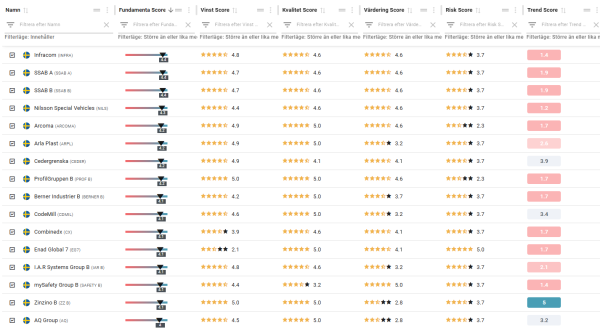Discover our factor ratings

Factor ratings: Profit, quality, valuation, risk and trend
We recently launched a new tab on company analysis page where we rate different factors. We have an aggregated rating for fundamentals, based on profit, quality, valuation and risk, which we ourselves can put in context with, for example, momentum or trend.
Using our ratings, we can easily create stock portfolios with exposure to one or more factors. We can choose to weight the companies equally, for example 20 companies with 5% each, or adjust the portfolio weights depending on how much a stock tends to fluctuate. Stocks with high volatility then receive a lower weight than stocks with lower volatility.
By acting systematically, we can avoid the major mistakes that often occur when trading based on emotion and subjective judgment. If we as investors manage to avoid these mistakes, we will have a major advantage over most others.
Factors can provide excess returns
Many studies have shown that factors can generate excess returns, meaning a better return than the broad market index over time. By creating exposure to different factors, we can develop strategies that potentially provide both higher and more stable returns than investing in indices alone. Research in financial economics shows that factors work either due to market inefficiency or as a premium for risk-taking.
Factor-based strategies have been successful for a long time, even though the concept itself has not always existed. These strategies were first used by market participants and later described in research. For example, Jesse Livermore traded momentum as early as the early 20th century, as described in the book Reminiscences of a Stock Operator. He is considered by many to be both one of the best and worst investors due to his successes and personal setbacks, when he tragically took his own life.
In the wake of the 1929 stock market crash, Benjamin Graham laid the foundation for value investing as a strategy with his book Security Analysis (1934) and further developed the concept in The Intelligent Investor (1949). Warren Buffett is often seen as a leading figure in value investing, but a large part of his returns come from investing in quality companies, inspired by Charlie Munger.
Today, there are hundreds of academic studies confirming that factors like value, quality, and momentum perform well over time. But that doesn't mean it's easy. Undervalued companies can be undervalued for shorter periods of time, quality companies can often be considered boring, and momentum stocks can often crash. If it were easy, it wouldn't work, which is why I like to use a systematic approach that eliminates strong emotions from decision-making.
Description of our ratings on various factors:
- Winning Score: Rating (1–5) of the company's profit development, changes in estimates and conditions for maintaining profit growth. In addition to the change in profit development, sustainable and non-sustainable components are also examined - for example, sustainable elements such as cash flow from core operations and operational efficiency, and non-sustainable elements such as one-off income and temporary cost savings. The higher the rating, the better the company's stability and long-term potential is considered to be.
- Quality Score: A score (1–5) on the company's fundamental quality, where the assessment is based on profitability, debt, earnings quality and dividends. Companies that demonstrate high margins and strong return on capital, combined with low debt, good earnings quality and a growing dividend, are given a higher score. It is worth noting that companies without dividends are not penalized, as the focus is primarily on long-term fundamental factors that indicate financial stability and quality.
- Rating Score: Rating (1–5) of the valuation based on several valuation multiples, including Trailing P/E, Forward P/E and Price/Sales. The valuation is compared both against the historical average for the stock and relative to the sector, with adjustments for the banking and real estate sectors. The higher the rating, the more attractive the valuation is considered.
- Risk Score: Rating (1-5) of the company's financial stability based on changes in debt, liquidity and interest coverage ratio. A company that has reduced its debt, improved its liquidity and strengthened its interest coverage ratio is reflected in a higher rating, indicating a healthier balance sheet and reduced financial risk.
- Trend Score: Price trend rating (1-5) based on both price and momentum over the short, medium and long term, with the greatest emphasis on the long-term primary trend driven by fundamentals. Our premise is that signals work best in line with the trend, but in the short term – from days to weeks – there is a lot of noise and random fluctuations.


